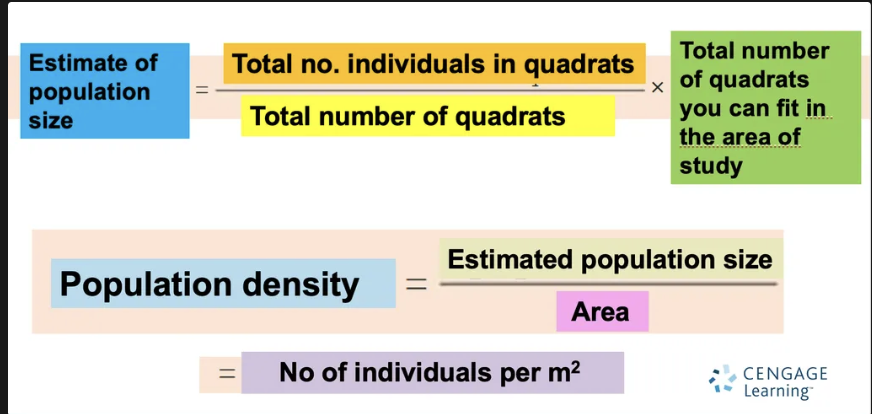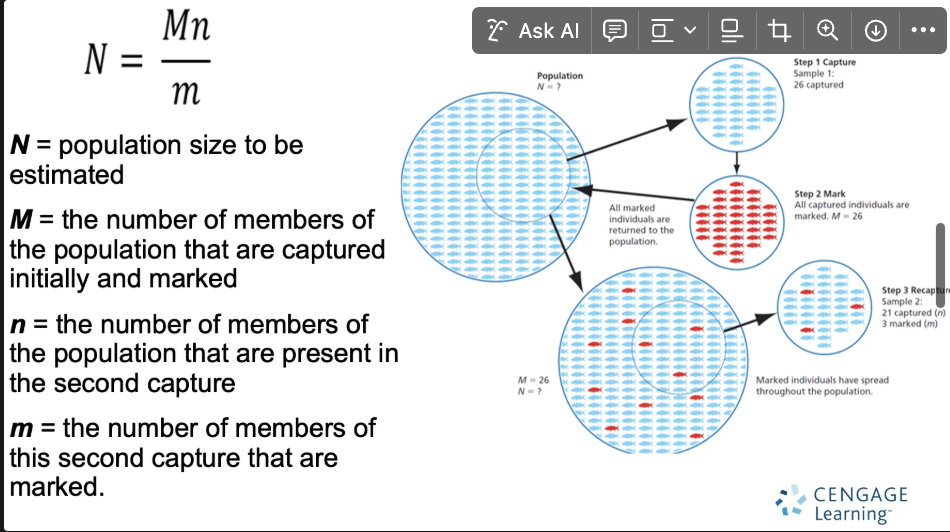Population Dynamics 5
1/24
There's no tags or description
Looks like no tags are added yet.
Name | Mastery | Learn | Test | Matching | Spaced |
|---|
No study sessions yet.
25 Terms
What are r-selected species?
a fast-growing and reproducing species, often the first to take up unused resources and living space
early colonisers in disturbed environments
known as opportunists
What is the life strategies of r-selected species?
species have a high birth rate
population explodes and reaches maximum reproductive potential of the species
then population declines or crashes in numbers
replaced by competitors during rapid decline
to survive, they must:
colonise new environments quickly
be able to reproduce rapidly in large numbers
What are the features of r-selected species?
smaller in size
have short life cycles
lack of parental care for young
What are K-selected species?
a slow-growing, long-lived species typical of those in a long-established biological community
What is the life strategy of K-selected species?
slow and steady’ life strategy
organisms reproduce at a slower rate (lower birth rate)
high level of parental care
offspring survival rate is much higher
What are the features of K-selected species?
larger in size
longer-lived species
fewer offspring
outcompete r-selected species
steadier population growth pattern
population numbers exist close to carrying capacity of environment
What is carrying capacity and what is it determined by?
the maximum population size of a species that can be supported in an environment with limited resources
as population density increases, competition increases
determined by:
the amount of resources (e.g. food, water)
predation
disease
competition between species (interspecific/intraspecific competition)
What are the different phases in population growth curves?
lag phase
exponential phase
transitional phase
plateau/stationary phase
Describe the lag phase.
population growth is slow
due to having few mating partners and they may be very widely dispersed in the environment
Describe the exponential phase.
high population growth
birth rate exceeds death rate
due to abundance of resources
maximum growth rate occurring under optimal conditions
no environmental resistance
environmental resistance - refers to environmental factors that hinder population growth (e.g. competition)
Describe the transitional phase.
population growth slows as environmental resistances has reached
increased competition for space, food, and mating partners
death rate increases and/or birth rate decreases
Describe the plateau/stationary phase.
carrying capacity (K) has reached
population has reached equilibrium
birth rate is roughly the same as death rate
limiting factors keep the population stable
fluctuations occur due to slight changes in birth rate and death rate
What are density-independent factors? Give examples.
environmental factors that occur not due to the size or density of a population
e.g.:
soil salinity
humidity
natural disasters
amount of rainfall
What are density-dependent factors? Give examples.
environmental factors that occur due to increase or decrease in population size and density
e.g.:
competition
disease
parasites
predation
food supply
Open vs closed ecosystems?
open ecosystem - migration occurs freely in response to environmental changes
closed ecosystem - migration does not occur but births and deaths still impact population size
Immigration vs emigration?
immigration = entering/moving to a new ecosystem/region
emigration = leaving an ecosystem/region
What is the population growth rate formula?
population growth rate = (birth rate + immigration rate) - (death rate + emigration rate)
What is direct observation in terms of measuring abundance?
sighting & counting
e.g. The Great Cocky Count
citizen survey count
What are quadrats?
a square, rectangular frame of convenient (appropriate) size used to mark out an area in which the vegetation is sampled
larger fields require larger quadrats and vice versa → gives a more precise estimate
e.g. 50x50cm for a backyard, 1-2m squares for medium-sized fields
used to estimate population size, population density, diversity
used on for immobile/sessile species
organism size, distribution & area are considered before deciding on quadrat size
placed randomly in the area to be studied without bias (quadrat throw)
if the centre of the species does not fall inside the quadrat, don’t count
How are quadrat throws beneficial?
the more quadrats that are thrown, the more accurate your estimate of population size/population density for a chosen species would be
if sufficient quadrats are chosen, your calculations would be representations of the area

What is quadrat sampling and its formula?
estimating population size and density using quadrats
know the total area of area you are studying
randomly select the quadrats to use for counting for a species you are estimating
record the data for each quadrat in your book
What is a transect?
line drawn through a community
information is gathered from along the line and used to estimate the distribution of species within that community
quadrats may be placed at intervals along the transect line to improve the data collected as data on density in specific locations may also be recorded
it is best to use the line transet method if environmental factors (e.g. soil type/soil pH/ soil salinity) change along the distance to be sampled
Why is the combination of using quadrats and line transects the best?
provides a full picture of population distribution and species abundance patterns in environments
data gathered using transects offers fairly accurate information regarding distribution of individuals and/or species
quadrats offer a comprehensive picture of species abundance but not distribution
Describe the process of capture-mark-recapture.
capture
animals are caught randomly without being hurt
small animals are trapped in cages/pitfalls in the ground, birds are trapped in fine nets
flying insects are attracted to light traps
mark (tag) and release
each capture animal is released so it is not obvious to predators/harmful to the organism
insects are usually marked with a small blob of paint, whereas birds are marked on the leg/wing
the animals are then returned to their habitat to allow them to re-disperse/mix back into the original population for some time
recapture
a random sample is taken from the whole population and the number of marked individuals in it is then counted
the timing of recapture needs to allow for the capture of a random mixture of individuals, but without leaving it so long that many of the original marked individuals have died
the number of marked organisms and the total number of organisms in the second capture is also recorded

What is the capture-mark-recapture formula?